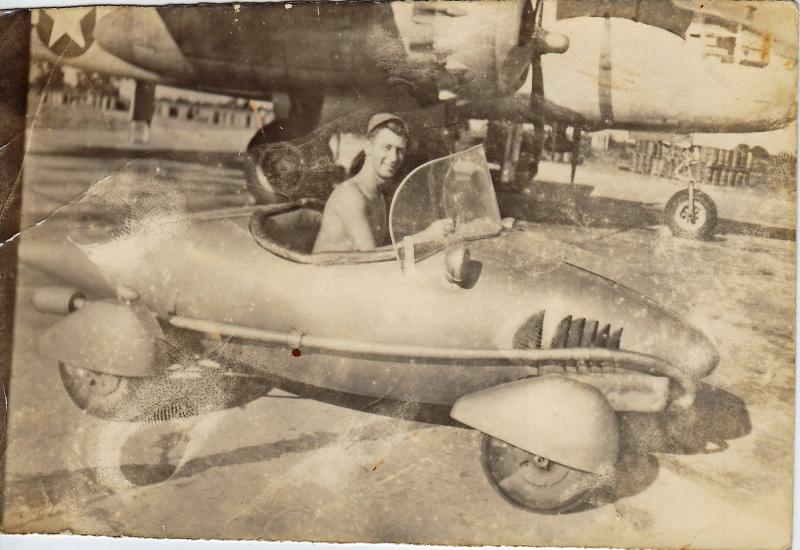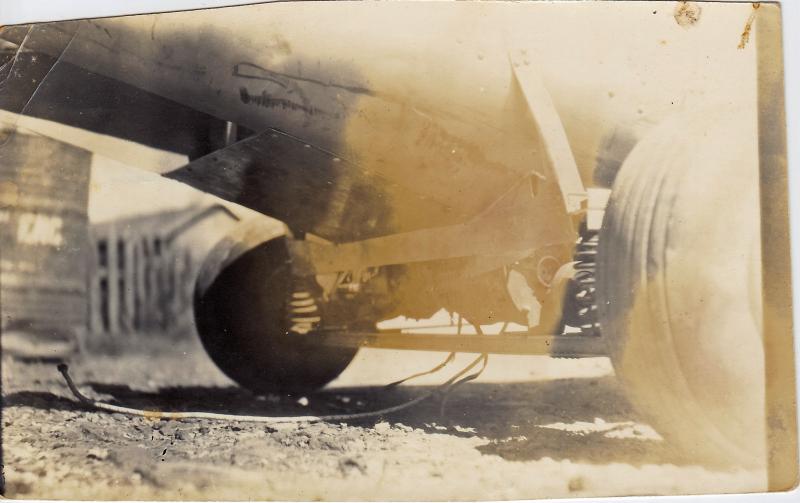TROTTERMATIC
electric car
George Trotter and the car without the strip of wing metal showing the fuel tank and generator engine used to power the electric aircraft starter motors on each wheel. George Trotter in the car with a Douglas C-54 Skymaster transport in the background
George Trotter in the car with a Douglas C-54 Skymaster transport in the background










Trotter Electric Car
This car was designed and built by George Trotter out of old aircraft parts at an airfield near Dacca, India ( now known as Dhaka, Bangladesh ) during World War II.
I have not been able to positively locate exactly which airfield near Dacca he served, but I have narrowed it down to two, either Tejgaon Airfield or Kurmitola Airfield. Tejgaon is currently being used by the Bangladesh Air Force and Kurmitola is now known as the Hazrat Shahjalal International Airport.
He used the drop tank from a plane for the body, the fenders are made from tail skids from B-25 bombers.
The power was produced from a gasoline powered 24 volt generator that provided DC electricity to a electric starter motor on each wheel. I suppose this would now be considered a hybrid car.
The reason for building this vehicle was to move the generator from one aircraft to another. There was a shortage of Jeeps to move the generator and the aircraft were widely dispersed to guard against aerial attack.Below is an article published in the Ex-CBI Roundup October 2004 edition.
Note: Ex-CBI Roundup is the official publication for the CBI Veterans Association for those that served in World War Two in the China, Burma and India theater of war. Here is a link to the Ex-CBI website. http://www.ex-cbi-roundup.com
My Electric Car
By George Trotter
I was an aircraft electrical specialist at the time and we were very short
of transportation, We had only one Jeep for the whole electric shop and
some 50 revetments scattered along 15 miles of taxi strip for protection
against enemy attack. We were expected to haul all the needed parts, along
with the technicians and auxiliary power supply, to these revetments where
we made the necessary repairs on planes. Being a “smart-alec,” I set out to
find a solution to the problem and came up with the idea for this car.
This car was made from a discarded gas tank that was split down the
seam and set apart 18 inches by a strip of wing metal. The wheels are small
wrecked plane wheels, the fenders are tail skids from B-25s. The power
source was a 24-volt auxiliary power plant (the same as we had been hauling
back and forth in the Jeep to furnish power needed for repairs).
This power plant kept two 24-volt aircraft batteries charged and the
batteries in turn, furnished power to drive the car and its accessories which
included electric brakes, lights, horn and self-starter. Its two speeds forward
was accomplished by building a switch that could put the two electric
driving motors either in parallel or in series. Reverse was acquired by simply
reversing the flow of current in the field windings. This was done by another
switch. Both of these switches were operated by solenoids and controlled
by switches which were handy to the driver. The accelerator and
brake control was, of course, on the floor in the normal positions, while the
other switches were on the dash board and marked for the benefit of unfamiliar
drivers.
The driving motors were two discarded 24-volt starters with part of their
reduction gear removed to give a more desirable gear ratio. These were connected
by direct drive shaft to each of the back wheels making a differential
unnecessary.
These motors were originally made to be used intermittently and normally
would have overheated, if used continuously. By drilling a system of
holes to channel cooling air through the aluminum housing and by rigging
a blower from an aircraft heater to force air through them, I was able to run
indefinitely without overheating.
As for performance, this car cruised at 35 to 45 miles per hour with the
driving motors in series. At this speed, one could flip the switch that puts
the motors in parallel and get the thrill of a drag racer. I never had the
nerve to find out what the top speed was, but it could pass a Jeep doing 65
with plenty to spare.
Needless to say, this car was a great help to our transportation problem.
It not only got us there, but it also furnished necessary power from its
built-in power plant.
George H. Trotter's diary during WWII - 1944



